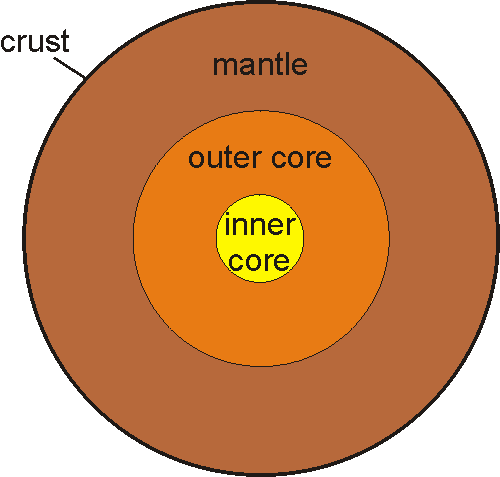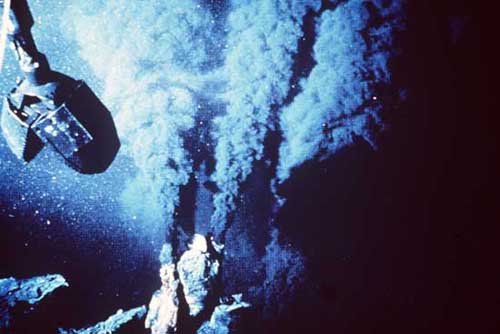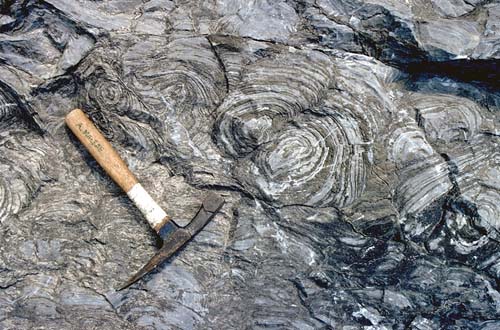|
|
||||||||
Planet Earth

To humans, planet Earth seems relatively unchanging. Photographs from space reveal the familiar shapes of continents, blue oceans and swirling clouds. But this impression of stability is deceptive. Over several billion years, our atmosphere has undergone dramatic changes in composition, and the climate has swung from "greenhouse" to "icehouse" conditions. 
The mechanism of plate tectonics has moved continents, created mountains and given birth to oceans. Erosion has worn mountain ranges down to their roots. Yet throughout (and in part probably because of) all this upheaval, life has evolved and become increasingly complex. How was the Earth formed, what happened in its early history, and how did life develop? Earth and the other rocky planets - Mercury, Venus and Mars - began to form more than 4.6 billion years ago. According to the latest ideas, within the developing solar system, cosmic dust and gases lumped together to form larger particles. These particles collided and stuck together (or accreted) due to gravity and kept on growing until they became planets. Asteroids, meteors and comets represent the leftovers from this process. Impacts at the surface of the early Earth, as well as radioactivity within it, heated our planet and caused it to melt, at least partially. 
Most of the heavier elements like iron and nickel sank and accumulated at the core, which thus came to be surrounded by lighter elements that ultimately formed the mantle and crust. For hundreds of millions of years after its formation, the Earth continued to be bombarded by meteors and comets. The surface was too hot for anything to survive or for oceans to form, and the atmosphere consisted of a noxious brew of carbon dioxide, nitrogen and water vapour with smaller amounts of methane, ammonia and sulphur dioxide. Oxygen, vital to most modern plants and animals, was absent. Consequently, there was no ozone layer to provide protection against the Sun's deadly ultraviolet rays. By about 3.8 billion years ago, the Earth had cooled enough for water vapour to condense and form permanent oceans, a necessary step before life could exist. But how did life first develop in the poisonous air and scorching climate of the primeval Earth? The coolest place was in the ocean, and the most nutrient-rich environment was around seafloor vents. 
However, sunlight could not have penetrated so far, and thus could not have been a source of energy. Inventive as ever, nature found a substitute for solar energy in certain gases, and a process known as chemosynthesis evolved. This is the breakdown of chemical compounds to produce the energy needed for life. Hydrogen sulphide, a gas expelled from volcanoes and deep sea vents, is one of the gases used to provide energy for animals and plants living in these apparently hostile environments today. Alternatively, life may have started when lightning, reacting with the primordial brew of organic-rich compounds in shallow ocean water, created some of the amino acids. Or perhaps, some combination of these events was responsible. Whatever happened, over eons the oceans and seas provided some protection from the harmful ultraviolet light of the sun while letting potentially beneficial sunlight penetrate. Ultimately, organisms harnessed sunlight to produce energy through photosynthesis, a giant leap forward in the evolution of life. The simplest living organisms known today are prokaryotes (cyanobacteria - formerly known as blue-green algae - and bacteria). A prokaryotic cell is one that does not have a nucleus, but does contain RNA and DNA, the building blocks of life. The oldest known fossils are prokaryotes from rocks 3.5 billion years old. These were probably cyanobacteria, which can photosynthesize, live in colonies and secrete a sticky substance that sediment sticks to, building up successive layers in mats or mounds called stromatolites. 
Stromatolites are the only fossils visible to the naked eye from Archean rocks (3.8 to 2.5 billion years old) and most Proterozoic rocks (2.5 billion to 545 million years old). Examples of Proterozoic stromatolites are found within the city limits of Saint John. Stromatolites declined about one billion years ago and appear only sporadically in the geological record after their decline. In the Maritimes, examples are found in Carboniferous rocks, about 340 million year old, near Hopewell Cape, NB and in Jurassic rocks, about 200 million year old, near Scots Bay, NS. Today, stromatolites are rare and are found only in warm shallow water that is very salty, thus preventing other organisms from grazing on the stromatolite-building cyanobacteria. By the early Proterozoic, about 2.2 billion years ago, the proliferation of cyanobacteria had "polluted" the Earth's atmosphere with oxygen, a by-product of photosynthesis. Oxygen was toxic to most of the organisms then living. Some scientists now estimate that in a relatively short period of time, geologically speaking (within perhaps 100-200 million years), the percentage of free oxygen in the atmosphere rose from essentially zero to about twenty percent of today's level. This major oxygenation is reflected in the rocks. The so-called banded iron formations of the Canadian Shield represent the rusting (or oxidation) of iron compounds dissolved in the ocean at this time. These formations, worldwide in geographic distribution but restricted largely to the Proterozoic in time, are the primary source of iron for today's steel industry. None are found in the Maritimes. The oxygen-rich atmosphere was possibly the stimulant necessary for the next major step in the evolution of life, the appearance of eukaryotic cells - cells with a nucleus. Eukaryotic cells are the basis of all multicellular animals and plants, and they led to a new and exciting episode in the Earth's history. The first eukaryotes, like the prokaryotes, were simple, microscopic, single-celled organisms. The decline in the abundance of stromatolites about one billion years ago coincides approximately with the earliest multicellular animals. This suggests that the evolution of multicellular grazers was responsible for the disappearance of most stromatolites. The rapid development of diverse life would have further increased the level of oxygen and hence the formation of the ozone layer. However, life in the Precambrian remained, primarily at least, in the sea, since the marine environment was more stable and there was less risk from harmful radiation and oxygen. The earliest evidence of animal macrofossils (that is, those visible to the naked eye) are the "Ediacaran" organisms, found in late Proterozoic rocks 600 million years old. 
Named after the Ediacara Hills in Australia, they are found as impressions of soft-bodied animals, and may be related to jellyfish, arthropods, molluscs, echinoderms and that Ediacaran organisms were a separate group unto themselves, totally unknown today. There are no known occurrences of Ediacaran fossils in the Maritimes, although Ediacaran-like fossils are found in early Cambrian sedimentary rocks in Saint John, NB. Geologists have long puzzled over the presence of thick suites of Proterozoic rocks derived from glacial deposits, immediately above which are carbonates (limestones and dolomites) that could only have been deposited in a warm ocean. Such suites of strata, about 700 million years old, are found for example in the Mackenzie Mountains of northern Canada and the African country of Namibia. Indeed, they are so widespread that the conditions that produced these sediments probably extended over the whole Earth. A recent idea, called the "snowball Earth" theory, provides a possible explanation for these unusual sequences of rocks. According to this theory, the Earth was indeed covered by ice, due to an extreme cooling event. After the break-up of the supercontinent Rodinia about 800 million years ago, the various new continents all drifted into more or less equatorial positions. Since more energy from the Sun bounces back into space from land than from the sea, and since the equatorial regions receive an undue share of the Sun's energy, the Earth retained less of the Sun's heat than normal while the continents were in this eqautorial arrangement. This situation set off a global deep freeze and much of the planet became covered with deep glacial ice. This was probably true for the parts of the future Maritimes that were in existence at that time, but no evidence of these events are preserved in our region. Meanwhile, volcanic activity remained the same as ever, and produced large quantities of such greenhouse gases as carbon dioxide, which became trapped beneath the ice. Eventually, these gases escaped and produce a runaway "greenhouse" affect. Not only did it become warm enough for the ice to melt, but tropical conditions ensued globally and carbonates were precipitated above the glacial deposits. As dramatic as this scenario is, there is as yet no better explanation for aspects of the late Precambrian rock record. This "snowball cycle" occurred at least twice, and perhaps three times within the last few hundred million years leading up to the Cambrian "explosion". Indeed, perhaps such dramatic environmental events were responsible in some way for the dramatic evolutionary events around the Precambrian-Cambrian boundary, about 545 million years ago. Since the Precambrian, the rock and fossil records suggest that the atmosphere has been relatively stable. For most of that time, it is thought that the composition has been about 78 percent nitrogen and 21 percent oxygen, the remaining one percent being a mixture of carbon dioxide, argon, methane, water vapour, ammonia and other trace gases. |
||||||||














